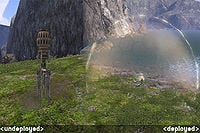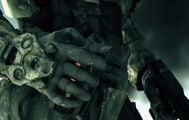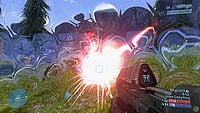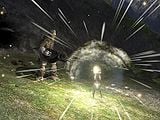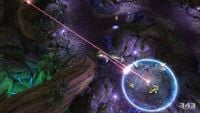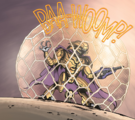Z-4190 bubble shield
From Halopedia, the Halo wiki
The Z-4190 Temporal Protective Enfolder/Stationary Shield,[1] commonly referred to as the bubble shield, is a personal defense device. It is Forerunner in origin, but the United Nations Space Command's Office of Naval Intelligence manufactured a number of the devices based on discovery of those formerly used by Warrior-Servants.[1] Even the Covenant reverse-engineered crude copies based on captured ONI prototypes.
History
Historically, the ‘dissipative’-style deployable energy shield system of the bubble shield is Forerunner in origin. Warrior-Servants utilized such a system to generate temporary fortifications using a sphere of interlocking hexagonal force enfolder elements,[1] similar to those used by Sentinels and Protectors. The technology was eventually discovered by ONI in the twenty-sixth century and was repurposed for use by the UNSC Armed Forces in the Human-Covenant War. In 2544, Spartan-II Blue Team used a bubble shield during Operation: WARM BLANKET.[2] HRUNTING/YGGDRASIL Mark I ADS suits utilized a form of bubble shield for protection.[3] Due to their size, mass, and relatively short power cell duration, along with low rates of production, Bubble Shields saw very limited use during the last stages of the Human-Covenant War.[1]
The drop shield is an advanced iteration of the bubble shield that was was developed by the Materials Group for ONI's Beta-5 strike teams. Drop shields saw usage during the Fall of Reach.[4] After Reach was defeated, Covenant forces recovered and copied ONI's shield prototypes, later employing their own cruder versions of bubble shields during the Battle for Earth and Battle of Installation 00.[5] These bubble shields projected a translucent, slightly white/gold tinted protective sphere around the user. The shield itself was similar to a geodesic dome, made of tessellating hexagons. The shield protected against bullets, explosions, lasers, plasma, flames, grenades, and other projectiles. Vehicles and personnel, however, were still able to pass through it. After approximately 20 seconds had passed, the shield would collapse and the generator would self-destruct. After the conclusion of the war, the Office of Naval Intelligence continued to manufacture a small number of similar devices, until 2555, when it refocused its shield research efforts towards Mjolnir-compatible emitters.[1]
During simulations of the Battle of Installation 03 and Battle of New Phoenix a Spartan-IV utilized a version capable of allowing the user to fire weapons at targets while remaining inside the shield.[6] On January 21, 2558, SPARTAN-G059 deployed a bubble shield against Avu Med 'Telcam to block his Type-51 carbine's rounds during her her assassination mission.[7] Both UNSC and Banished forces utilized bubble shields with infantry and vehicles during their battle over Installation 00 in April 2559.[8]
Gameplay
In Halo 3's campaign, Brutes deploy bubble shields often. At least one or two Brutes in a Covenant pack always have a bubble shield on hand. Brutes generally activate their bubble shields immediately when taking fire or when feeling threatened. Unlike the multiplayer "shield doors", vehicles are able to pass through the bubble shield. Damaging the shield generator itself in the bubble's enclosure will cause it to explode, and the shield will collapse upon detonation. Upon reaching its energy limit, bubble shields will make a high-pitched sound prior to overloading and exploding.
Disadvantages
- Enemies can enter the shield freely.
- The bubble shield only lasts about 20 seconds. In combat, however, this is more than enough time to regroup and recover.
- If either the player or an enemy throws a grenade inside the bubble shield, it stays inside and will more than likely kill almost everyone in the shield at that time. This strategy is most effective with spike grenades, as the spikes will bounce around and shred anything inside the shield.
- The generator is very delicate, and if shot from the inside, it will quickly explode and destroy the bubble shield.
- Vehicles can also enter bubble shields. Therefore, you can run somebody over while they are still in the bubble shield.
- The bubble shield can be affected by other equipment if thrown within the shield's proximity. For example, if an opponent throws in a Portable Gravity Lift near the generator, the Gravity Lift can raise the shield generator up, leaving anyone previously inside the shield defenseless. Additionally, effects from equipments can also be limited in the shield; if a Regenerator is thrown inside the bubble dhield, only those within the shield are affected. Likewise, if a power drain is thrown inside an active bubble shield, the disabling effects of the power drain are contained within the bubble shield.
- The bubble shield can be knocked away by throwing a power drain or radar jammer at the generator, causing both objects to roll, and leaving anybody previously inside the shield exposed.
Trivia

|
See our gameplay information related to Z-4190 bubble shield on its gameplay page. |

|
Browse more images in this article's gallery page. |
- An early form of the bubble shield was used in the original teaser trailer for Halo 3. It is shown being used by John-117 to protect him from an incoming Wraith mortar. In the teaser trailer, the bubble shield looked like a type of grenade, leading to rumors that it would be one of the new grenade types.
- The original bubble shield was smaller than the finished bubble shield, as seen in the Starry Night video. It stuck into the ground rather then just stood on top of it; it was also originally in a grenade form, seemed more like a personal device and looked similar to Invincibility, another piece of equipment.
- In the Beta version of Halo 3, the bubble shield looked and rolled like the power drain, did not glow gold, had orange lights, and was able to protect players against the turrets guarding the outer perimeter of the Multiplayer map Snowbound.
- If you look closely at the bubble shield, you can see that there are actually two layers of shields that comprise it.
- In Halo Wars, a Shield Protector will deploy a bubble shield-like object onto selected friendly units.
- Although it appears in Halo 3: ODST, it cannot be used by the player or by other allies; only Brutes. This may be because of its extreme weight, weighing in at 20.5kg. This may also be the reason why Marines are not seen using it in Halo 3 and Halo 3: ODST. In fact, it may never had been intended for personnel-deployment purposes.
- The bubble shield is replaced by the drop shield in Halo: Reach. It is a combination of the bubble shield and the regenerator. The bubble shield is much stronger than the drop shield, which could only take one Wraith shot.
- The Covenant artillery is one of the few weapons powerful enough to destroy a bubble shield.[9]
- If one looks closely at the deployed bubble shield, you can see it "pulses" as though the shield were breathing.[10]
- The bubble shield is capable of negating the effects of a Kill Ball, allowing players to go inside the ball.
Gallery
An early model of the bubble shield in the Starry Night trailer.
The bubble shield is capable of blocking practically all forms of attack throughout its duration, including Spartan Laser shots. Note the clear color from the Halo 3 Beta.
The bubble shield being used in Halo: Spartan Strike.
List of appearances
- Starry Night (First appearance)
- Halo 3
- Halo Wars
- Halo 3: ODST
- Halo Legends
- The Package
- Odd One Out (non-canon appearance)
- Halo: Spartan Strike
- Halo: Tales from Slipspace
Sources
- ^ a b c d e Cite error: Invalid
<ref>tag; no text was provided for refs nameduniverse - ^ Halo Legends: The Package
- ^ Halo Legends: Prototype
- ^ Halo: Reach
- ^ Halo 3
- ^ Halo: Spartan Strike
- ^ Halo: Tales from Slipspace, Knight takes Bishop
- ^ Halo Wars 2
- ^ Halo Encyclopedia
- ^ Halo Encyclopedia

